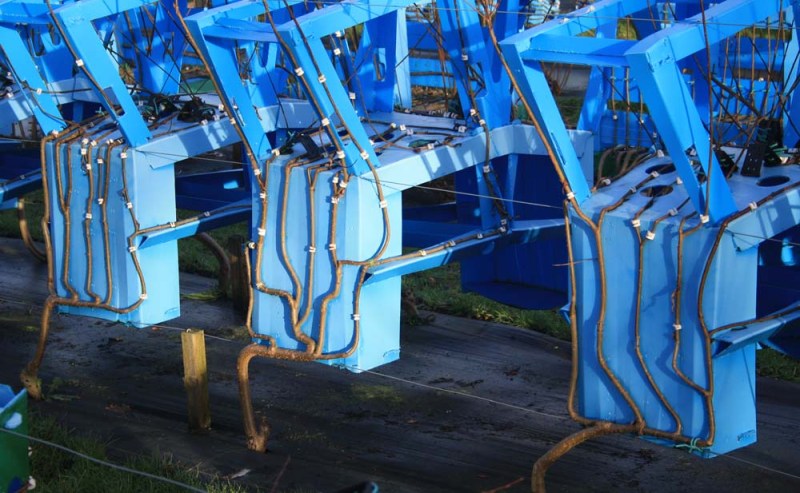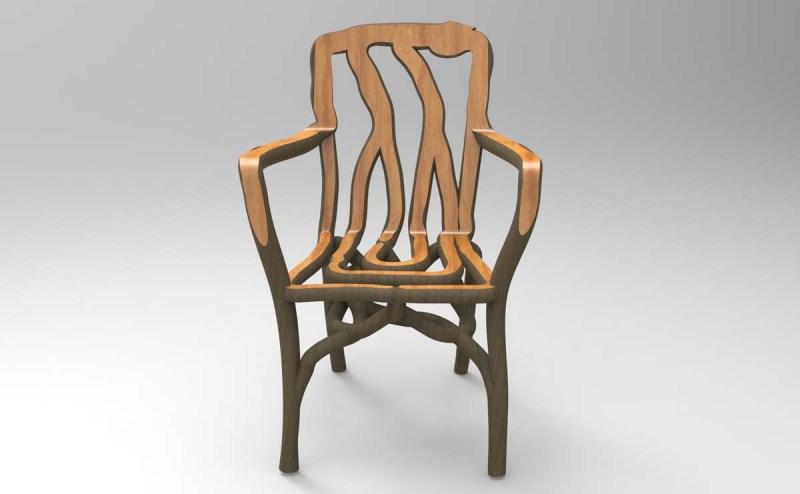[Gavin Munro] is turning the standard paradigm of furniture making on its head. Instead of harvesting trees and slicing them up into boards – or worse, turning them into sawdust to be used for particle board – [Gavin] is literally growing furniture.
Supple young willow saplings are pruned and trained using wire and plastic form work. The trees are encouraged to grow in the right directions to form legs, arms, seat and back, and eventually the individual pieces are grafted  together to continue growing into one solid piece. When the chair is mature, the leaves are removed, the chair is cut free from the ground, and with a little seasoning and finishing, you’ve got a unique and functional chair. And what’s more, since it’s a solid piece of wood, there are no joints to loosen over time.
together to continue growing into one solid piece. When the chair is mature, the leaves are removed, the chair is cut free from the ground, and with a little seasoning and finishing, you’ve got a unique and functional chair. And what’s more, since it’s a solid piece of wood, there are no joints to loosen over time.
You’ve got to admire the dedication that goes into these chairs. The current crop is about nine years old and still a few years from harvest. There’s a lot to be learned from the organization of a project like this – planning a production line where the first finished pieces are a decade or more from the showroom is no mean feat. Looks like [Gavin] has thought that through as well, by starting a line of lamps that will be turning a profit sooner. The video after the break demonstrates not only [Gavin’s] chairs and lamps, but also features his first harvest of tables.
Thanks to [Sascho] for the tip.

















Looks like he could benefit from this http://www.sciencedaily.com/releases/2015/04/150416083355.htm
Too bad can’t quite do this with bamboos directly.
https://en.wikipedia.org/wiki/Bamboo
>Bamboos are some of the fastest-growing plants in the world,[2] due to a unique rhizome-dependent system. Certain species of bamboo can grow 35 inches within a 24-hour period
Now that’s some crazy fast growing renewable materials that the Chinese have been using for ages…
I believe that you can train bamboo. The problem is that the fast-growing bamboo species tend to also degrade rapidly after the plant has died.
The other issue is that bamboo can’t be grafted like the willow can (afaik)
doubt that would be helpful poplar is a very light wood with relatively low physical strength even if they could make other types of fast growing trees I’m certain the material property would be quite different from a “normal” tree making it a worse choice for furniture….
I just love the way he grows the chairs upside down. It makes perfect sense when you see it.
All the weight rests on the segments with least cross section. I feel like you’d be better off growing a tree per leg and entwining them through the seat and back. Even the previous tree-come-chair link, with a single trunk leg, would be more structurally sound than this.
I like the concept, could use some refinement.
he’s not sitting in a grown chair :(
Awesome stuff. And to think that I was pleased when I put a glass bottle over an apple as it was growing on the tree to impress my nephew with a magic trick.
Bloody hell, they’re incredible.
This reminds me of Paul Laffoley’s architecture. (The dude, almost undeniably completely crazy, wanted to build a space elevator between the earth and the moon made out of vines. The logistics are nuts, but the drawings are beautiful.)
I was told you can not do this, I came up with the idea a while ago. Oh well.
Always be suspicious of people who tell you something can’t be done..
Yea like all those anti zero point energy bashers. Sheesh.
Always be suspicious of people who say always.
Only the Sith deal in absolutes.
Always…
People have already been doing this for quite awhile way before this guy did it. What is different is that the chairs were typically one-off creations and this guy is doing mass production.
The department head of my industrial design program wouldn’t let me work on consumer oriented 3d printers as a thesis project in 2005ish… “They will never be mainstream” he said.
If I ever see that guy again….
Very nice.
I’ve heard of synthetic plant hormones which can significantly boost growth. And which are available to the average person. No genetic modification necessary, unlike [fl@C@]’s idea; I guess you just spray or water with them. Though I don’t know much more, including whether any would work on willow, result in weaker wood, or be cost-effective in this application. Or whether, even if it worked perfectly and economically, it would be considered an unacceptable “cheat”.
Most of the plant growth hormones are the same that make willow a fast, easy growing species. The compound you’re thinking of is probably Indole-3-butyric acid. You can actually make your own rooting hormone but steeping a bunch of fresh cut new willow growth in water for a couple weeks. This makes plant propagation much more reliable in some cases, though in many it’s barely worth the effort.
Is this an actually profitable venture?
it seems very novelty-investment. the long-term time-focus investment is small, but the immediate for maintaining each plantgroup is perhaps a weekly thing. you could easily have a Dayjob and still do this on the side
Prices on the lamps available by inquiry only. You know that old saying, “if you have to ask about the price, it’s too expensive for you”? That’s just the lamps, so it’s a safe bet the chairs will be INCREDIBLY FREAKIN’ EXPENSIVE. And that it will be profitable. But not scalable, there’s only so many customers out there for which price is no object, and who like your product.
I expect Al Gore will be a big customer of his…
lamps start at 700 GBP, mirrors from 450GBP, chairs from 2500GBP. (according to BBC story on his page)
It has potential if it could be scaled up- grow furniture on a larger plantation, use the excess material after harvest for biomass (mulch/power/etc)
It could be. There are other ventures where revenue starts a significant number of years after first establishment of the business. e.g. I remember Olive trees only start bearing fruit after 30 years or so. And Whisky takes several years to ripen. The trick is to stick it out while your first batch matures, and keep on adding new batches every year (or something).
Not profitable if is sits around doing nothing while they grow. Find the right buyers, they are gracy if he is making $10-$200 a hour, while they grow.
@WaterJet: It’s not about the monetary profit, it’s about reducing waste. If you’re still here in 100 years time you’ll probably be on youtube watching that video wishing more people followed this idea.
Your kidding me right? Waste of trees? For every one we cut down, 3 are planted. In a 100 years, I’ll be coming back saying how pointless tree conservation is, because they’re everywhere.
Wow, that’s just asking for an ent moot.
nexxt stop grow an entire house.. ( maybe a few years of a project ) but why not
I didn’t think much of this idea at first, but it’s growing on me.
I read a short story some 35 years ago called (IIRC) “The Mad House”, in which whole houses were grown like trees. If you were naughty, you got thrown in the “Mad House”, that was very, very angry at everyone in it.
A local pub has chairs and tables made from crafted tree root. No joints here either!
http://img1.wfrcdn.com/lf/49/hash/4483/13027294/2/Tree+Root+Peacock+Chair.jpg
http://www.wayfair.co.uk/Ancient-Mariner-Tree-Root-Peacock-Chair-IS02-L2291-K~ANC1260.html?refid=GX51210266423-ANC1260&device=m&ptid=129739800503
That looks a lot like teak root. The company I work for used to deal in teak furniture but it’s not a very high margin product. The costs in exporting it from Asia are astronomical, and it’s a shrinking market.
Are there any plants that can grow in a few hours? People these days have short attention spans.
What if you use tubes to guide the growth/propagation into a chair shape. The canopy spreads out from the upper end of the tubes and us cut off when the chair is “harvested” and used to grow the next chair. The tube-guided process is quite hands-off compared with what this fellow is doing. If you can get several chairs a year per plant, I would think the tube approach would have good margins at far lower prices than the hands-on approach – say at $200 per chair an order of magnitude less.
you have to splice the branches together so you don’t leave seams, which is impossible with the tubes because you couldn’t remove the tubes afterwards without breaking
I prefer the CG generated chair in to first photo…nice art project
Well. This is simply incredible and mind blowing.
This idea has been around for decades in many forms. I have seen ideas for even growing houses this way. It’s sound, but the harvest cycle is what limits its use. There is one plant that is better suited, it’s power to weight ratio is excellent, its growth time is one season, easily grafted, and all the byproducts are easily reused lol…so, who’s state is it legal to make a cannabis version? :)